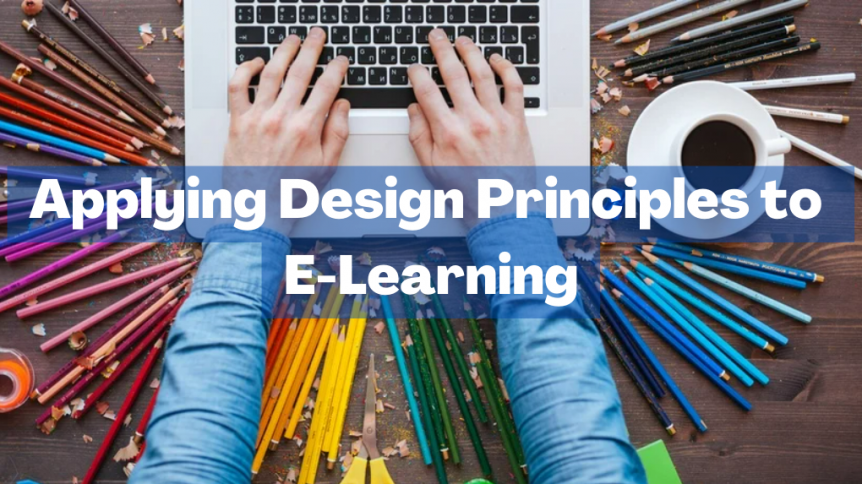Applying Design Principles to E-Learning
Good design in e-learning doesn’t happen by accident. To achieve good design, you must follow established design principles.
Design principles are guidelines that influence how users interact and engage with e-learning content. They can even be used to make an emotional connection with learners. As a result, design principles contribute to the learner experience, enhancing it when implemented properly.
There are many design principles that graphic designers and artists use, but there are eight that are fundamental in e-learning design.
Balance
Balance is concerned with the distribution of various visual elements on the screen. This includes everything from the content to images to navigation buttons and links.
Balance in design also means ensuring there is design consistency. Navigational buttons are a good example. You could have buttons for next, previous, and home all on the same screen – they should be the same size and style. Their positioning should also be balanced, i.e., the next and previous buttons should be positioned in relation to each other.
The final consideration with balance in e-learning involves achieving a good balance of content types, including text, images, video, animation, and gamification.
Unity
Unity is about creating a sense of oneness when considering the course as a whole. You might choose a bright and energetic style for the design of your e-learning course, for example. This should then be carried through to every content element and screen, as including something that is more reserved or subdued would break the unity of the design.
Another example is where you explain steps to complete tasks. If you display each step on a single screen for one task, this approach should be applied to other tasks, as opposed to using a different method for explaining the steps.
Unity is a concept that also applies to content as much as it applies to design. For example, there should be a consistent tone of voice throughout the course to achieve unity. So, if you decide on a conversational tone of voice, this should be applied throughout.
Alignment
Alignment involves making sure the various elements on the screen are connected to each other in a way that is pleasing to the eye and that doesn’t distract the learner. The alignment of text (left, right, or centre) is an obvious example. However, alignment also applies to all other visual elements on the page, including headlines, buttons, images, and more.
Alignment doesn’t just involve connecting elements on the screen, as alignment to the margins is also important, especially when creating an e-learning course that can be completed on a mobile device. You need to make sure there is a sufficient margin in your design, plus margins should remain consistent.
Movement
Movement in design has several functions:
- Draws the attention of learners to a particular content point on the screen
- Engages the learner by adding something different and interesting
- Helps explain a concept or topic
An example of the latter is to add movement to a graph to highlight change over time or how different situations affect outcomes.
Caution should be applied to movement in design. After all, we have all seen PowerPoint presentations that are so overloaded with unnecessary animation that it detracts from the message.
In fact, you can achieve movement by being very subtle. For example, adding a progress bar to the top of each screen.
Contrast
Contrast is about using different elements on the screen to attract the attention of learners and keep them engaged with the content. In design, contrast is most often thought of in relation to colour palettes, but contrast can also be achieved by bright and dull, thick and thin, and large and small elements.
A button on the screen is a good example. A low contrast button will be a similar colour to the background or too small compared to other elements on the screen. This will make less of a visual impact than if the button is high contrast, both in terms of colour and size.
Contrast also plays an important role in readability and accessibility.
Repetition
Repetition in design is about consistency, so involves using the same colours, fonts, background, and style throughout your e-learning course. Repetition is also about using design elements repetitively.
For example, if you start using white icons on a coloured background, don’t suddenly change to coloured icons on a transparent background. Instead, repeat the design style throughout the course. The same applies to lines, shapes, buttons, quizzes, navigational elements, and more.
Proportion
Proportion is about the size of elements on the screen and how those sizes relate to each other. There are two important points to remember when it comes to proportion. The first is that the scale of elements should be visually appealing. For example, the difference in size between a screen’s main heading, sub-headings, and text.
The second point is about consistency. For example, you should avoid reducing the size of a heading to make it fit on the screen, as doing so will impact proportion in the design.
Emphasis
Our final design principle is emphasis, so involves the focal point of the screen. In other words, attracting the attention of learners and using design to show them what they should do next.
For example, the opening page of your e-learning course should emphasise the most important message you want to present, as well as what you want the learner to do next. In most cases, this will be to tap a button to start the course.
This should then be carried through the rest of the course, with the design guiding the learner through the content, i.e., if you want the learner to read text before watching a video, make this clear in the design.
Following the Guidelines of Good Design in E-Learning
As you can see from the design principles highlighted above, they don’t tell you how to create a design. Instead, they are guidelines that should be followed to ensure the design is not only visually balanced and pleasing, but also that it contributes to the learning experience and helps you achieve your training goals.

